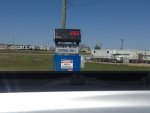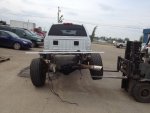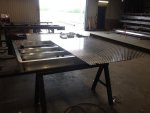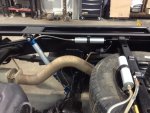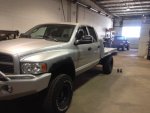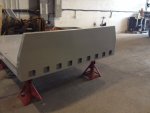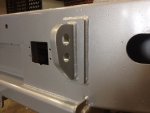So a few years ago, I built a nice Ford F-650 to comfortably haul 4 people and sleep up to 6 for our families travels, we race cross country and hare scrambles plus do a lot of off road riding. In the past we used your typical RV but after killing 2 motorhomes, 2 travel trailers, and having the family space requirements exceed the limitations of our Bigfoot camper on our F-450 (the ONLY camper that had no issues after 2 years of good use) the F-650 was born. We are running it for the 4th consecutive year, with no issues, 50% of our travel is on rough unimproved gravel roads. It is light for its size, roomy, safe, warm, lots of water and power, we are able to run extended periods without issue, it has travelled through 2 provinces and 6 states in the name of fun.
Recently my son and I have been starting to do a lot more day trips, which is usually 300-500 km's of driving plus a full day of hard riding, it would be nice to shoot out the night before, and be there for the crack of dawn, but I don't like driving the big rig out with the trailer for one nights sleep for just the 2 of us. It is always stocked and ready to go for the whole family which is usually a minimum of 3 days supplies, plus she burns diesel at 9 MPG so in this circumstance it's a little bit of a job to use it. My F-650 has proven itself, and I have got a lot of positive feedback from the racing community, a lot of people deal with the same issues we used to. So after a lot of inquiries I decided to investigate the possibilities of building a platform that would service our sport as well as survive the kind of travelling we do, like a lot of people on this forum do.
The build is a 2004 Dodge 2500 crew cab long box diesel, it's my truck, with only 150 000 KM's on the odometer, and in mint well maintained condition. It's been a great truck and if I replace it, I want to be able to unbolt everything and drop it on to a new chassis. The deck will be aluminum, the build will be extremely focused on the limitations within the factory chassis and vehicle capacities, keep unnecessary weight out, and keep function number 1 and aesthetics right behind. The camper will follow the same philosophies, I have been working with composite panels for a few years in some very harsh environments, and I have designed a line of extrusions that will make the build relatively straight forward, and extremely strong with a little bit of flexibility built into the entire structure.
Recently my son and I have been starting to do a lot more day trips, which is usually 300-500 km's of driving plus a full day of hard riding, it would be nice to shoot out the night before, and be there for the crack of dawn, but I don't like driving the big rig out with the trailer for one nights sleep for just the 2 of us. It is always stocked and ready to go for the whole family which is usually a minimum of 3 days supplies, plus she burns diesel at 9 MPG so in this circumstance it's a little bit of a job to use it. My F-650 has proven itself, and I have got a lot of positive feedback from the racing community, a lot of people deal with the same issues we used to. So after a lot of inquiries I decided to investigate the possibilities of building a platform that would service our sport as well as survive the kind of travelling we do, like a lot of people on this forum do.
The build is a 2004 Dodge 2500 crew cab long box diesel, it's my truck, with only 150 000 KM's on the odometer, and in mint well maintained condition. It's been a great truck and if I replace it, I want to be able to unbolt everything and drop it on to a new chassis. The deck will be aluminum, the build will be extremely focused on the limitations within the factory chassis and vehicle capacities, keep unnecessary weight out, and keep function number 1 and aesthetics right behind. The camper will follow the same philosophies, I have been working with composite panels for a few years in some very harsh environments, and I have designed a line of extrusions that will make the build relatively straight forward, and extremely strong with a little bit of flexibility built into the entire structure.


